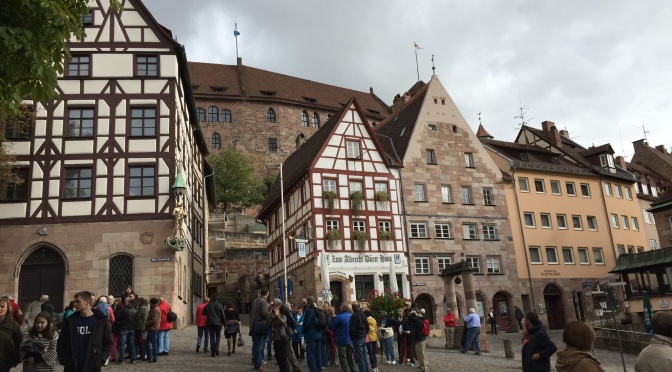This was an interesting day: starting out with evidence of the absolute megalomania of Hitler, followed by the beauty of the old fortress, and then to the amazing amount of work done to save the works of art in and around the city from being destroyed during WWII.
The bus from the ship took us around the area where Hitler held his massive rallies once a year. 10,000 shouted their allegiance to “The Fuhrer” in the massive Zeppelin Field during the Nazi regime and he had plans to build a new Congress Hall to rival the Roman Colosseum but only 2/3 of the outer structure was completed before the end of the war. It is now used as a documentation centre (in one small part of it) and the rest of the structure is used for storage of Christmas market stalls. Since we were driving around and through it in a bus, I could not hope to get an adequate picture of the size of this complex. It was fitting that, immediately afterwards, we drove by the Palace of Justice, the venue of the Nazi war trials.
The 13th century walls (3 miles in all), gateways, and 80 original watch-towers are still intact around the old city of Nuremberg. Amazingly, most were not destroyed during WWII (some were reconstructed). We walked around the medieval Palace within the walls, and then ventured down into the town which is still highlighted by half-timbered houses, Gothic fountains and churches. The market area was busy with many stalls and various street performers, including a musician whose dog sat on a cushion on top of his accordion – a great draw for tourists and, surprisingly, the dog seemed to be enjoying himself as well!
After the tour Tony and I found a traditional restaurant that served Nuremberg bratwurst (by this time we had learned that each town has its own speciality). Nuremberg sausages were a specified width – thin enough to be stuffed through the keyhole after forced closing time of an establishment (although we didn’t find out how they got the requisite beer through that same keyhole!). The standard fare is 6 sausages and either sauerkraut or a rather sloppy potato salad on a traditional v-shaped plate. We shared both.
Then we did a tour of the art bunkers of Nuremberg. Originally built as beer cellars, these underground caves were fortified with insulation and air conditioning to enable the preservation of centuries-old artifacts from Nuremberg and further afield. The displays throughout the rooms show how priceless statues, stained glass windows, and paintings were taken down, crated, and stored in these caves. The “Monuments Men” (art historians in the US army) managed to prevent the looting and theft of many pieces of art stored here during the Battle of Nuremberg. Photos were discouraged but I could not help but take a photo near the end of the tour of an exhibit showing a few of the bombs that fell on the city.
In the final few “rooms” there were two fascinating videos showing the major buildings after the battle and what they looked like after reconstruction, and then the plan for the city after the war and how they decided what to restore and what to tear down and start over. From what we saw – the reconstruction effort was immense and incredibly well done. We went into St. Sebaldus Church after the tour, having seen how the stained glass windows were saved and somehow they had much greater significance than they would have otherwise.
As we wandered through the town square afterwards, there was a party atmosphere – a number of people were dancing and there was wine and beer as well as bratwurst and other delicacies to purchase. An Italian fair was taking place on the bridge on our way back to the bus – it was tempting to try some wine and pasta but…dinner awaited on the Bragi.
